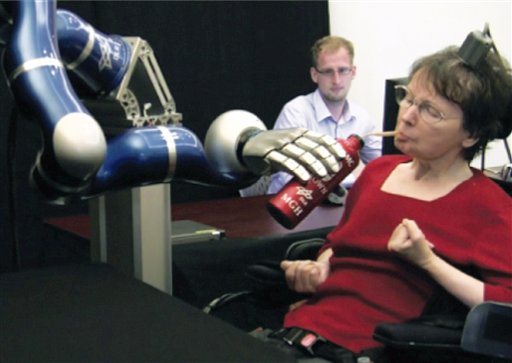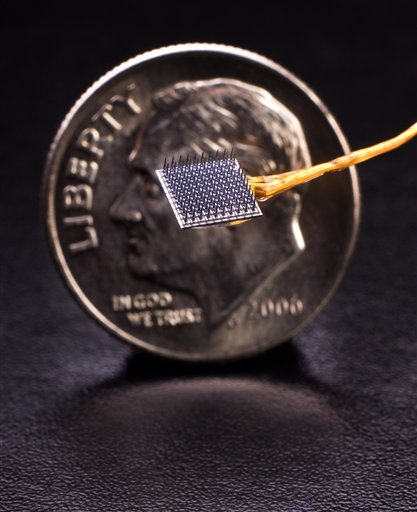NEW YORK (AP) - Using only her thoughts, a Massachusetts woman paralyzed for 15 years directed a robotic arm to pick up a bottle of coffee and bring it to her lips, researchers report in the latest advance in harnessing brain waves to help disabled people.
In the past year, similar stories have included a quadriplegic man in Pennsylvania who made a robotic arm give a high-five and stroke his girlfriend's hand, and a partially paralyzed man who remotely controlled a small robot that scooted around in a Swiss lab.
It's startling stuff. But will the experimental brain-controlled technology ever help paralyzed people in everyday life?
Experts in the technology and in rehabilitation medicine say they are optimistic that it will, once technology improves and the cost comes down.
The latest report, which was published online Wednesday in the journal Nature, comes from scientists at Brown University, the Providence VA Medical Center in Rhode Island, Harvard Medical School and elsewhere.
It describes how two people who lost use of their arms and legs because of strokes years before were able to control free-standing robotic arms with the help of a tiny sensor implanted in their brains.
The sensor, about the size of a baby aspirin, eavesdropped on the electrical activity of a few dozen brain cells as the study participants imagined moving their arms. The chip then sent signals to a computer, which translated them into commands to the robotic arms.
The computer was taught how to interpret the brain patterns through practice as the paralyzed participants watched the robot arms move and then imagined that they were moving their own arms the same way.
 |
| In this April 12, 2011 image from video provided by braingate2.org, Cathy Hutchinson of East Taunton, Mass. sips a drink held by a robotic arm during a test at a long-term care residence for adults with neurological disease in Dorchester, Mass. A report by researchers published in the Thursday, May 17, 2012 issue of the journal Nature describes how two people, paralyzed years before by strokes, were able to control free-standing robotic arms with the help of a tiny sensor planted in their brains. The sensor, about the size of a baby aspirin, eavesdropped on the electrical activity of a few dozen brain cells as the people imagined moving their arms. It then sent signals to a computer, which translated them into commands for the robot arms. (AP Photo/braingate2.org) |
In one task to test the system, the two participants tried to direct a robot arm to reach out and squeeze foam balls in front of them. The man succeeded in less than half his attempts, but the woman was able to do it about 60 percent of the time.
The woman, Cathy Hutchinson of East Taunton, Mass., was also asked to use the arm to drink the coffee. That involved picking up the bottle, bringing it to her lips so she could sip from a straw, and putting the bottle back on the table. She succeeded in four out of six tries with the arm, which was specially programmed for this task.
"The smile on her face ... was just a wonderful thing to see," said Dr. Leigh Hochberg, a researcher with the Providence VA, Brown and Massachusetts General Hospital.
Researchers said in Hutchinson's case that the results show that the implanted chip still worked after five years, and that her brain was still generating useful signals even though she hadn't moved her arms in almost 15 years.
The ultimate goal, researchers said, is an implanted device that would reactivate a person's own paralyzed limbs. Another goal is to operate high-tech prostheses for amputees.
Andrew Schwartz, who is doing similar research at the University of Pittsburgh, said the coffee-sipping was encouraging because it represents an everyday task a paralyzed person might want to do. "I think it's showing this technology has therapeutic potential," he said.
"The field is rapidly advancing, and I think this offers hope for people who are paralyzed," Schwartz said. "The types of movements we'll be able to do are getting more and more sophisticated at a rapid pace."
 |
| This 2006 image provided by braingate2.org shows a sensor which is designed to collect signals in the brain to be translated by a computer to move a robotic arm. A report by researchers published in the Thursday, May 17, 2012 issue of the journal Nature describes how two people, paralyzed years before by strokes, were able to control free-standing robotic arms with the help of the sensor planted in their brains. The sensor, about the size of a baby aspirin, eavesdropped on the electrical activity of a few dozen brain cells as the people imagined moving their arms. It then sent signals to a computer, which translated them into commands for the robot arms. (AP Photo/braingate2.org, Matthew McKee) |
But he and others said the technology faces a number of hurdles to widespread use, like reducing its high cost, making it more reliable, and refining the technology. For example, the brain implant now sends signals out with a wire through the skull, and researchers want to develop a completely implanted version that communicates wirelessly.
Another step toward wide use will be enticing companies to invest the money to make commercial products. Just when that might happen is an open question, Schwartz said, but it could be in the next couple of years, with prostheses or free-standing robotic arms on the market a few years after that.
Dr. Bruce Gans, executive vice president and chief medical officer of the Kessler Institute for Rehabilitation in West Orange, N.J., said the technology is too expensive now for widespread use. But if brain control finds uses outside the relatively limited market of paralyzed people, that might drive improvements in technology and dramatically reduce the cost, he said.
Gans suggested other uses might involve industrial applications; neuroscientist Andrew Jackson of Newcastle University in England suggested it might be in rehabilitation for victims of less severe strokes.
At some point, Gans said, "It may even turn into something that allows a person with paralysis to go back to work, so it becomes a tool a vocational rehabilitation program could eventually endorse and support."
Dr. Preeti Raghavan, an expert in physical rehabilitation of the arms and hands at the New York University Langone Medical Center, noted that the cost of the technology would be weighed against the significant expense of caregiving for paralyzed people who can't do much on their own.
She said she expected that within a decade, many people may be using the technology to control their own limbs or robotic arms. Gans said that wider use of robotic arms might be feasible within five years, but that reactivating paralyzed limbs could be decades away.
Page created on 5/17/2012 12:00:00 AM
Last edited 8/22/2021 6:52:19 AM
